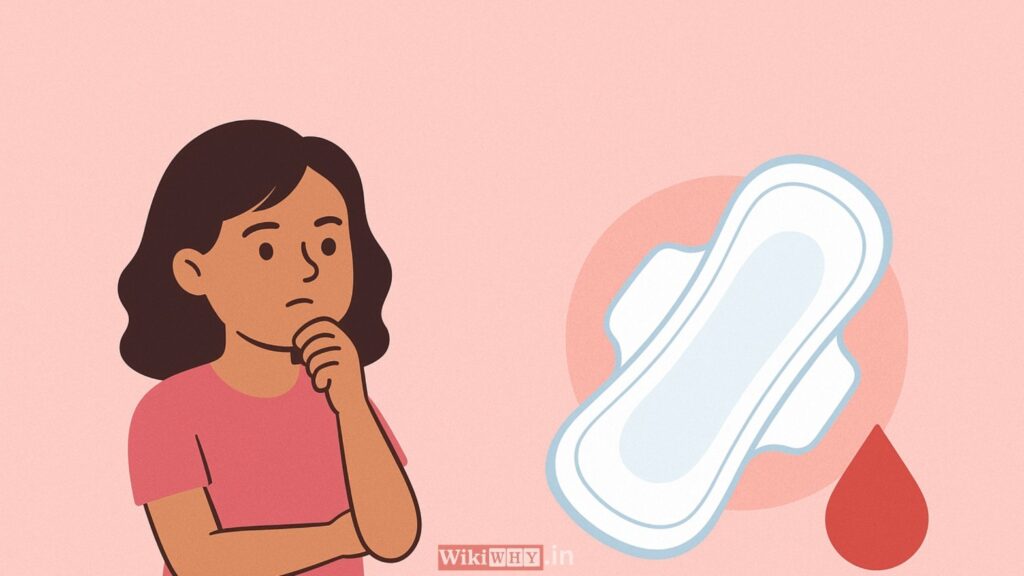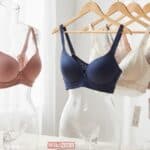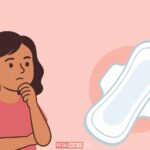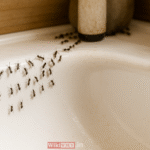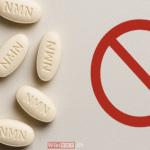
Dr. Priyanka Dorage
BAMS • MD (Ayurveda)
Assistant Professor at Maharashtra University of Health Sciences. Research author specializing in integrative Ayurveda and modern medicine. Published in multiple peer-reviewed journals.
Key Publication:
“Integrative Approach on Post-COVID-19 and Infertility: A Literature Review” (IJAM, 2023)
Every month, over 1.8 billion women and girls globally go through a biological process known as menstruation (period). It is a sign of a healthy reproductive system and occurs when the body releases a little blood from the uterus. This process shows your reproductive cycle is healthy and lasts 3 to 7 days. Menstruation generally begins in females between 10 and 15 years of age.
Throughout these days to stay clean and comfortable, most girls use sanitary pads(Sanitary Napkins). A sanitary pad is a soft, absorbent item that soaks up menstrual blood. And it keeps one’s clothes clean, avoiding leakages or stains.
Sanitary napkins maintain good hygiene and prevent infection or skin irritation due to prolonged wetness. Over 70% of girls in developing nations use sanitary pads as their main menstruation product since they are simple to use, inexpensive, and safe. Pads allow girls to go to school, work, and social events without pain or embarrassment.
Why Do Girls Use Pads?
Girls used sanitary pads to remain clean, comfortable, and confident while menstruating. Pads prevent blood from flowing, leaking, or staining and keep the skin fresh and dry. This prevents rashes or infections. Girls can walk freely, attend school, play, or engage in daily activities without any concern when they wear ladies’ sanitary pads.
Sanitary pads also help in managing bad odour and ease cleanliness during menstruation. Simply put, girls’ pads are for remaining safe, clean, and carefree during menstruation.
What Are Sanitary Pads?
Sanitary pads (sanitary napkins) are soft pads that girls wear during their periods. Sanitary napkins absorb menstrual blood and keep the body clean and dry. A woman’s sanitary pad also has various layers. The upper layer of the sanitary napkin is soft against the skin, and the middle layer consists of cotton or blood-absorbing gel that absorbs the blood. The lower layer prevents any leakages. Some pads also have wings on the sides to keep the pad from clothing stains.
Sanitary pads for girls come in different options and thicknesses. Some pads are designed for light flow, and others are for heavy flow days. The pads need to be replaced every few hours to remain fresh and clean. A sanitary napkin photograph typically depicts a flat pad with a sticky side that adheres to the underwear.
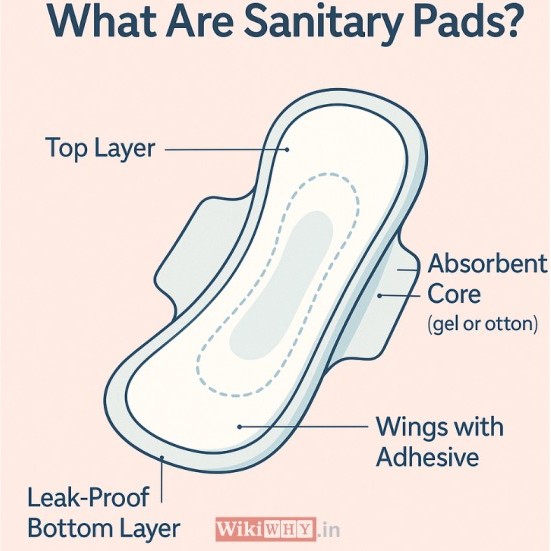
Types of Sanitary Pads
Here is the complete list of sanitary pad types:
- Regular Pads: For average or medium duration flow.
- Large Pads for Periods: For heavy or night wear.
- Thin Pads (Ultra-thin Pads): Thin and soft to allow ease of movement.
- Thick Pads (Maxi Pads): Additional layers for added absorption.
- Small Pads for Periods: For light or final days of periods.
- Mini Pads for Periods: For spotting or very slight bleeding.
- Small Pads for Daily Use: They keep you fresh even when off periods.
- Discharge Pads: These pads are for everyday vaginal discharge or slight leaks.
- Night Pads: Wider and longer to prevent leaks during sleep.
- Scented Pads: Smell good to prevent bad odour.
- Unscented Pads: Fragrance-free pads for sensitive skin.
- Biodegradable Pads: Made of natural fibre, earth-friendly.
- Reusable Cloth Pads: They can be washed and reused numerous times.
- Organic Pads: Made of pure cotton without chemicals.
- Maternity Pads: Large pads are used after delivery.
How Can You Choose the Right Pad Size?
The right women’s pad size provides comfort during your period. Pads are available in various sizes and thicknesses. You can choose as per the amount of flow you have.
On light flow days, small pads (thin pads) may be used. For heavy flow or nighttime use, you must opt for large pads. Heavier periods that can hold more blood and avoid leaks. For sensitive skin, choose rash-free pads made of soft cotton for maximum comfort. Brands such as Nua Pads provide various sizes and types so that each girl can pick what feels most suitable for her body and flow.
How Often Should You Change Pads?
You must switch sanitary pads regularly to remain clean and healthy throughout your period. Physicians recommend replacing your pad after 4 to 6 hours, even if the flow appears to be light.
Keeping a single pad on for extended periods may lead to bad smells, rashes, or even infections. The blood and wetness provide a warm environment for germs to multiply. For girls with heavy flow, more frequent changing of pads prevents leakage and discomfort.
How Can You Use a Sanitary Pad?
Here is how you can use a sanitary pad:
- STEP 1: Wash your hands with soap first.
- STEP 2: Unpack the pad.
- STEP 3: Remove the paper to expose the sticky side. Leave the long side in the middle.
- STEP 4: Stick the pad on the underwear.
- STEP 5: Fold the wings under the underwear so the pad doesn’t shift. Check the fit. The pad should be snug and cover the area well.
- STEP 6: Change every 4–6 hours (earlier if there is heavy flow).
- STEP 7: Wrap the used pad in paper or packaging.
- STEP 8: Do not flush it into toiled toilet but discard it in a trash can.
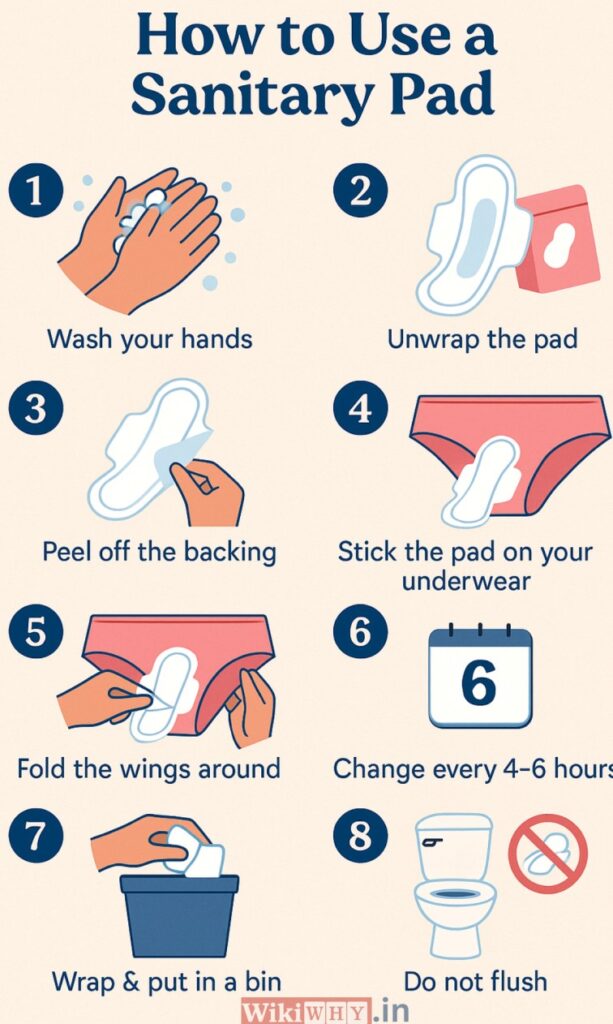
Go Green with Biodegradable and Reusable Pads
Environmental Impact of Regular Pads: Conventional sanitary pads are made of up to 90% plastic (polyethylene, polypropylene, and super-absorbent polymers). According to a 2019 Menstrual Hygiene Alliance of India (MHAI) report, over 12.3 billion sanitary pads are disposed of annually in India alone. Most of these take 500–800 years to decompose, polluting landfills, water bodies, and releasing toxic gases when burnt.
Hence, many girls now opt for environmentally friendly sanitary pads that are safe for the body as well as the environment. Biodegradable sanitary napkins are made from natural and biodegradable materials such as cotton, bamboo fibre, or banana fibre. Additionally, it easily decomposes after disposal and causes no harm to the environment.
Reusable cotton pads are still another great choice. These pads are composed of soft, washable cotton, so you can use them again for a few months. They save waste, are economical, and are good for the skin. Choosing biodegradable or cloth pads promotes eco-friendly menstrual hygiene.
The Takeaway Message
It is absolutely normal, healthy, and necessary for girls to use sanitary pads. Pads make girls feel clean, comfortable, and confident during their menstrual cycles. It allows them to go about their daily lives without anxiety.
Teachers and parents should speak openly about menstruation. When the grown-ups talk about periods openly, it makes young girls better aware of their own bodies and more self-assured. All girls must have access to safe menstrual products and accurate information.
Frequently Asked Questions
Why do girls use pads?
Girls use pads during their periods to absorb menstrual blood and stay clean. Pads help prevent stains, odour, and discomfort, allowing them to continue daily activities confidently.
What is the main purpose of a sanitary pad?
The purpose of a sanitary pad is to maintain menstrual hygiene by safely absorbing period flow. It keeps the vaginal area dry and prevents infections or irritation.
How often should a girl change her pad?
A pad should be changed every 4 to 6 hours. Changing it regularly prevents rashes, itching, and bacterial growth, ensuring good menstrual hygiene.
Can sanitary pads cause rashes or irritation?
Yes, wearing a pad for too long or using one with synthetic fragrance may cause rashes. Using cotton-based or organic pads and changing them on time helps prevent irritation.
Are sanitary pads safe to use?
Yes, sanitary pads are completely safe when used properly. They are made to protect the skin and absorb menstrual flow effectively. Organic pads are ideal for sensitive skin.
What should a girl do if she gets her period at school?
If a girl gets her period unexpectedly at school, she should ask a teacher or friend for help. Most schools keep pads in the nurse’s room or restrooms. Staying calm and clean is key.
How should used sanitary pads be disposed of?
Used pads should be wrapped in paper or the pad’s cover and thrown in a dustbin. They should never be flushed, as that can block drains and harm the environment.
Why is menstrual hygiene important?
Maintaining menstrual hygiene prevents infections, promotes comfort, and boosts confidence. It also helps girls and women manage their periods safely and with dignity.

